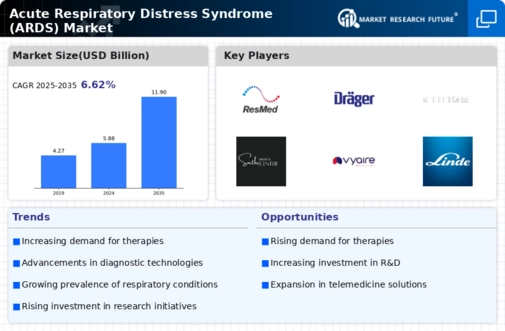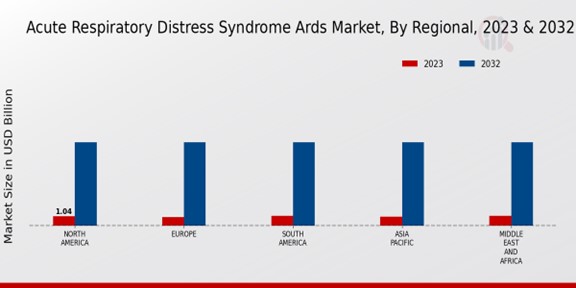Market Growth Projections
The Global Acute Respiratory Distress Syndrome (ARDS) Market Industry is poised for substantial growth, with projections indicating a market value of 5.88 USD Billion in 2024 and an anticipated increase to 11.9 USD Billion by 2035. This growth trajectory reflects a compound annual growth rate of 6.62% for the period between 2025 and 2035. Factors contributing to this expansion include rising incidence rates, advancements in medical technology, and increasing awareness of ARDS. As healthcare systems worldwide adapt to these dynamics, the market is likely to evolve, presenting opportunities for stakeholders to invest in innovative solutions and improve patient care.
Rising Geriatric Population
The aging population is a significant driver of the Global Acute Respiratory Distress Syndrome (ARDS) Market Industry. Older adults are more susceptible to respiratory diseases, including ARDS, due to age-related physiological changes and comorbidities. As the global population ages, the demand for ARDS-related healthcare services is expected to rise. This demographic shift is likely to contribute to the market's growth, with projections indicating a market value of 5.88 USD Billion in 2024. Healthcare systems worldwide must adapt to this increasing demand by enhancing ARDS management strategies, thereby fostering a more comprehensive approach to respiratory health in the elderly.
Emerging Therapeutic Options
The Global Acute Respiratory Distress Syndrome (ARDS) Market Industry is experiencing growth due to the emergence of novel therapeutic options. Research into new pharmacological agents and treatment protocols is ongoing, with promising results in improving ARDS outcomes. The introduction of targeted therapies and biologics may revolutionize the management of ARDS, potentially leading to better survival rates and reduced morbidity. As these innovative treatments become available, they are likely to attract significant investment and interest from healthcare providers. This trend aligns with the projected market growth, with an expected increase to 11.9 USD Billion by 2035, underscoring the importance of continuous innovation in ARDS management.
Increasing Incidence of ARDS
The Global Acute Respiratory Distress Syndrome (ARDS) Market Industry is witnessing a surge in demand due to the rising incidence of ARDS cases. Factors such as environmental pollution, smoking, and respiratory infections contribute to this trend. In 2024, the market is projected to reach 5.88 USD Billion, reflecting the urgent need for effective treatment options. As healthcare systems globally adapt to these challenges, the focus on ARDS management is likely to intensify, prompting investments in research and development. This increase in prevalence not only drives market growth but also highlights the necessity for improved diagnostic and therapeutic solutions.
Growing Awareness and Education
The Global Acute Respiratory Distress Syndrome (ARDS) Market Industry benefits from heightened awareness and education regarding ARDS among healthcare professionals and the general public. Initiatives aimed at improving understanding of ARDS symptoms, risk factors, and treatment options are gaining traction. This increased awareness is likely to lead to earlier diagnosis and intervention, ultimately improving patient outcomes. As educational programs proliferate, healthcare providers are better equipped to manage ARDS cases effectively. This trend may contribute to the market's anticipated growth, with a compound annual growth rate of 6.62% projected for the period between 2025 and 2035, reflecting the positive impact of education on healthcare practices.
Advancements in Medical Technology
Technological innovations play a pivotal role in shaping the Global Acute Respiratory Distress Syndrome (ARDS) Market Industry. The development of advanced diagnostic tools and treatment modalities, such as non-invasive ventilation and extracorporeal membrane oxygenation, enhances patient outcomes. These advancements are expected to contribute significantly to the market's growth, with projections indicating a rise to 11.9 USD Billion by 2035. The integration of artificial intelligence in patient monitoring and treatment protocols further streamlines care delivery. As healthcare providers increasingly adopt these technologies, the overall efficiency and effectiveness of ARDS management are likely to improve, fostering a more robust market landscape.


















